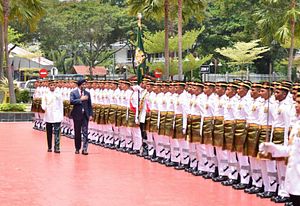Harjit Singh Sajjan just concluded the first ever trip by a Canadian defense minister Malaysia this week in the 60-year history of the bilateral relationship. His visit is testament to both Canada’s growing involvement in Southeast Asia as well as the importance it attaches to the its ties with Malaysia and in the defense realm in particular.
As I have written previously, though Canada has in fact been one of the longest-serving ASEAN dialogue partners, by most metrics, ASEAN-Canada ties have taken off over the past few years (See: “Canada’s Pivot to ASEAN”). Canada has increased its diplomatic, economic and security attention to individual Southeast Asian countries as well as ASEAN as a whole, even though it continues to face some challenges in its engagement which range from resource constraints down to sheer awareness about its role in the subregion.
This year presents a good opportunity to both increase visibility and boost cooperation given that it is the 40th anniversary of Canada’s partnership with ASEAN, with the usual slew of commemorative activities planned for the year. And Singh’s visit this week, which came amid port calls by two Royal Canadian Navy frigates – Her Majesty’s Canadian Ships Winnipeg and Ottawa – was one of several interactions that demonstrates the country’s role, especially in the security domain. Canada was one of the founding members of the ASEAN Regional Forum (ARF), and though it is still left out of key political-security forums such as the East Asia Summit (EAS) and the ASEAN Defense Ministers Meeting Plus (ADMM-Plus), it has been an important partner in addressing some security issues ranging from terrorism to disaster relief.
Singh’s visit also signifies the importance of the Canada-Malaysia bilateral ties. This is the first-ever visit by a Canadian defense minister to Malaysia in the relationship, and it comes as both countries commemorate the 60th anniversary of relations. During his trip, Singh met with several top Malaysian officials, including Defense Minister Hishammuddin Hussein and Foreign Minister Anifah Aman.
Much of the visit was dominated by defense matters, which is no surprise given Singh’s role. During his meeting with Hishammuddin, both defense ministers discussed regional and global issues but also specific areas of cooperation including terrorism amid the rise of the Islamic State (IS). Local media reported that Singh welcomed the establishment of the King Salman Center for International Peace (KSCIP), a new center between Malaysia and Saudi Arabia which is designed to counter radical ideologies and promote Islam as a religion of peace and moderation (See: “Where is the New Malaysia-Saudi Arabia Counterterrorism Center?”).
At a press conference on board the Winnipeg, Singh also highlighted the contribution Canada had made to Malaysia in terms of military training since 1966, with over 500 armed forces personnel having benefited from the Military Training and Cooperation Program. He added that Canada wanted to look at how it could further this part of its defense relationship with Malaysia. Other Canadian officials, including Canadian High Commissioner to Malaysia Judith St. George and Defense Attaché Colonel Janine Knackstedt, were also present.
































